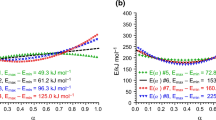Abstract
Alkaline fading of bromophenol blue was chosen for the investigation of the effect of heating rate on the activation energies derived from the dynamic kinetic method. Freeman and Carroll's treatment was adopted to compute the activation energies from experimental data taken with three heating rates: namely 1°, 0.5° and 0.25°/min. It was found that the activation energy increases as the heating rate decreases. This is attributed to the non-equilibrium conditions. By extrapolating to zero heating rate, the activation energy obtained is comparable to that obtained via classical isothermal kinetics.
Résumé
On a choisi la décoloration du bleu de bromophénol en milieu alcalin pour étudier l'influence de la vitesse de chauffage sur l'énergie d'activation calculée à partir des données fournies par une méthode d'étude cinétique dynamique. On a adopté la méthode de Freeman et Carroll pour calculer les énergies d'activation à partir des données expérimentales obtenues avec trois vitesses de chauffage, à savoir 1°, 0.5° et 0.25°/min. On montre que l'énergie d'activation augmente quand la vitesse de chauffage diminue. On attribue ce phénomène aux conditions de non-équilibre. En extrapolant pour une vitesse de chauffage nulle, on obtient une énergie d'activation comparable à celle calculée par la méthode classique en cinétique isotherme.
Zusammenfassung
Die in alkalischem Medium erfolgende Entfärbung von Bromphenolblau wurde zum Studium des Einflusses der Aufheizgeschwindigkeit auf die nach der dynamischen kinetischen Methode erhaltenen Aktivierungsenergien herangezogen. Das Verfahren von Freeman und Carroll wurde zur Berechnung der Aktivierungsenergien aus Versuchsdaten, welche bei drei Aufheizgeschwindigkeiten, nämlich 1°, 0.5° und 0.25°/min erhalten worden waren, verwendet. Es wurde festgestellt, daß die Aktivierungsenergie mit abnehmender Aufheizgeschwindigkeit zunimmt. Der Grund hierfür wird den Nicht-Gleichgewichtsbedingungen zugeschrieben. Wird auf Aufheizgeschwindigkeit=0 extrapoliert, so ist die erhaltene Aktivierungsenergie mit der nach klassischer isothermer Kinetik erhaltenen vergleichbar.
Резюме
Обесцвечивание в щел очной среде бромфено ла синего было выбнано д ля исследования влияния скорости наг рева на величини энергии активации, ра ссчитанной по данным динамическог о метода. С целью расче та энергии активации по экспери ментальными данным, полйченным при трех с коростях нагрева (1°, 0,5°, и 0,25°/мин) использован метод Фримена и Керро ла. Установлено, что эн ергия активации увеличива ется по мере уменьшения скор ости нагрева.
Similar content being viewed by others
References
D. T. Y. Chen, J. Thermal Anal., 6 (1974) 109.
E. S. Amis andK. La Mer, J. Am. Chem. Soc. 61 (1939) 905.
D. T. Y. Chen, andK. J. Laidler, Can. J. Chem., 37 (1959) 599.
S. R.Dharvadkar and M. D.Karkhanavala, India At. Energy Comm. Bhabha At. Res. Cent., BARC-381 (1968).
Author information
Authors and Affiliations
Rights and permissions
About this article
Cite this article
Chen, D.T.Y. Effect of heating rate on activation energies derived by a dynamic kinetic method. Journal of Thermal Analysis 7, 61–64 (1975). https://doi.org/10.1007/BF01911625
Received:
Revised:
Issue Date:
DOI: https://doi.org/10.1007/BF01911625




